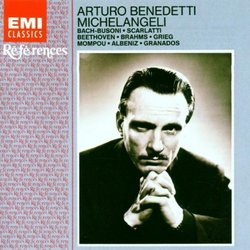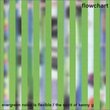| All Artists: Arturo Benedetti Michelangeli Title: Piano Works Members Wishing: 1 Total Copies: 0 Label: EMI Import Release Date: 1/19/1993 Album Type: Import Genres: Dance & Electronic, Classical Styles: Chamber Music, Forms & Genres, Short Forms, Sonatas, Historical Periods, Baroque (c.1600-1750), Classical (c.1770-1830), Romantic (c.1820-1910), Instruments, Keyboard, Strings Number of Discs: 1 SwapaCD Credits: 1 UPC: 077776449029 |
Search - Arturo Benedetti Michelangeli :: Piano Works
 | Arturo Benedetti Michelangeli Piano Works Genres: Dance & Electronic, Classical
|
Larger Image |
CD DetailsSimilar CDs
|
CD ReviewsA compilation of most of Michelangeli's earliest recordings, Discophage | France | 07/04/2008 (5 out of 5 stars) "This is a nice compilation and an indispensable one for the Michelangeli admirer, gathering most of the pianist's earliest studio recordings, made between 1939 and 1948, including three substantial pieces: Beethoven's 3rd Sonata opus 30/3, Brahms' Paganini Variations and Bach-Busoni's Chaconne (there is a very good discography available on the net). In chronological order you get:
1939 Granados Andaluza (track 20 -indeed Michelangeli's first extant recording) Grieg At the cradle and Melancholy (tracks 16 & 17) 1941 Beethoven Sonata n° 3 (Tracks 4-7) 1942 Albeniz Malaguena (track 19) Mompou Cancion y danza n° 1 (Track 18) Scarlatti Sonata K9/L413 and K11/L352 (tracks 2 & 3) 26 & 27 October 1948 Brahms Paganini Variations (tracks 8-15) Bach-Busoni Chaconne (track 1) Among the recordings from those early years, missing are some Chopin (Mazurka op 62/2, Scherzo # 2, Waltz op 69/1), Debussy (Reflets dans l'eau), Galuppi (Presto) and Marescotti (Fantasque) from 1941, Grieg (Erotik op 43/5) and more Chopin from 1942 (Berceuse, Mazurka op 33/4), two Scarlatti Sonatas, Bach's Italian Concerto and Tomeoni's Allegro from 1943. But at 78:28 the References disc is as generous as it can be. Unlike Rimsky-Korsakov, there is no composer called "Bach-Busoni", of course, no more than there is a "Mussorgsky-Ravel". In Busoni's arrangement of Bach's great Chaconne from the 2nd Violin Partita, Michelangeli adopts a relatively pressing and urgent tempo, lacking the kind of meditative grandeur conveyed by Tatjana Nikolayeva in her 1982 Japanese recital (Bach, Toccata and Fugue / 'Jesu Bleibet Meine Freude' / Chorale Prelude / Fugue - Nikolaeva). But he applies strong contrasts of tempo (piu mosso, ma misurato at 2:12, then dolce espress. at 3:46, con fuoco animato at 4:45, etc) and plays with an almost Schumanesque bounce, eliciting great tension, and his "con fuoco" passages are fiery indeed. He can also play with much power, quite appropriately lending the piece a texture reminiscent of the organ. It is not the complete Paganini Variations that Michelangeli plays, but his own reordered concoction, which concludes book II with variations 3 & 4, sends I/13 and I/14 (of which he plays only the dazzling coda, starting measure 293) at the end after book II to form a grand finale, and omits I/9, II/9 and, most regrettably, the finale of book II (var. 14). The playing is masterful, on a par with Petri's 1937 recording (available in a number of reissues: Brahms/Paganini/Handel: Varia, Brahms: Violin Concerto; Violin Sonata, Op. 108; Variations on a Theme of Paganini or Egon Petri: His Recordings 1929-1942, Vol. 2 - I have the two latter), well up to the piece's technical (just try the first three variations) and musical demands. He launches into I/1 with muscularity and sweep, but unlike many he does play the dynamic swells and accents written by Brahms. Likewise he has fine dynamic nuance in I/2 & 3 or again in I/12 and II/12 where he plays the sections' repeats at a softer dynamic level. Michelangeli's control of voicing is often remarkable, as in I/11 where he changes the emphasis between right and left hand. Variations II/5 to 8, played without break, are taken at dazzling speed and with admirable lightness of touch, and likewise with II/11, while I/13 has great Gipsy swagger. It is a high-strung approach with little repose, and Michelangeli takes even the "slow" variations with forward movement (I/11 & 12) and an undercurrent of Romantic turbulence (I/10, II/2 & 12), eliciting little sense of calm until II/4 (which in Michelangeli's sequence comes at the very end). Truth is, sometimes he lets the virtuosity take the upper hand, as in I/4 where he lets the left hand get blurred and lacks inner voicing. Likewise, it doesn't sound as he is playing the right-hand and left-hand 16th notes that Brahms wrote in II/1, nor the arpeggiated 32nd notes as Brahms wrote them in II/8, but rather as struck chords. There is an audible shift back in sonic perspective with I/8, due presumably to a change of 78rmp side. I haven't done the same kind of thorough discographic comparison with Beethoven's Sonata as with the two previous pieces, but taken on its own Michelangeli's reading seems wonderfully dynamic, brash and youthful. And a post-script from Feb 2009: Naxos historical has just released, in Europe only, a CD which partly duplicates the contents of this one (see ASIN B001HBX8RS on the European sister companies): you get the two missing Scarlatti Sonatas, the Galuppi, Marescotti and Tomeoni pieces and Bach's Italian Concerto but you loose the Grieg trifles and Beethoven's Sonata. So it is really a choice between Beethoven and Bach. I'll stick with this one. " |

 Track Listings (20) - Disc #1
Track Listings (20) - Disc #1


